Apple's most affordable Mac mini is 18 years old
For 18 years, the Mac mini has bounced between adored and abandoned, even by Apple, but so far it has always come back -- and it remains a remarkable workhorse.
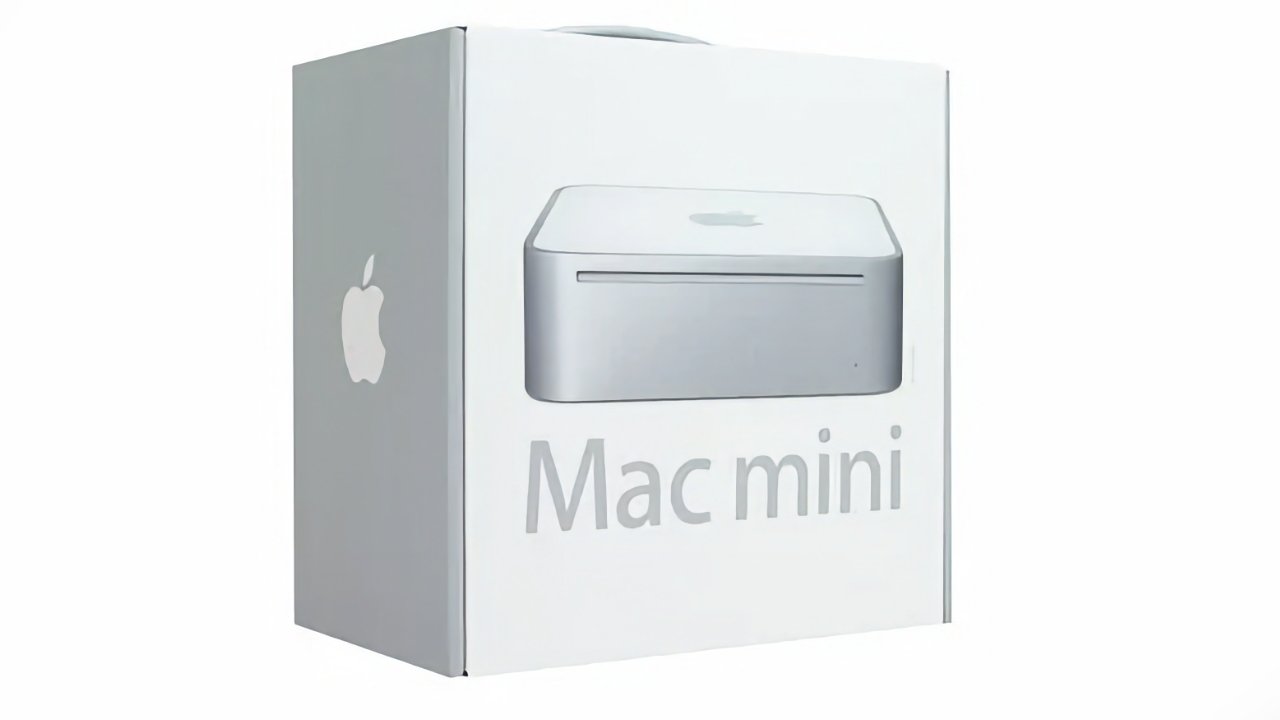
The original Mac mini box in 2005
According to Apple's playbook, you don't ever say "cheapest," you must say "most affordable." It's like the risible way the company started saying things like "half an inch thin" instead of thick.
But someone forgot to tell Steve Jobs this, because at the unveiling of the very first Mac mini on January 10, 2005, he doubled down on that exact and seemingly dreaded line.
"This is the most affordable Mac ever," he began. "In fact it's the cheapest computer Apple's ever offered."
Note that some sources say the announcement was on January 11, 2005. But that is because Apple's official press release about it wasn't issued until the 11th.
"Cheap" has connotations of corners being cut, of the price even being the only good thing about something. In this case, though, no one could criticize Apple of trimming features or build quality to save some cash.
"Weighing in at just shy of 3 pounds and only 6.5 inches square by 2 inches high," said AppleInsider at the time, " the Mac mini has the smallest form factor of any Macintosh ever produced. Its footprint is similar to the Power Mac G4 Cube, but about 1/3 the height and 1/10th the weight."
But there's no question that price was foremost in Apple's mind when Jobs stepped out onto the stage at Macworld in January 2005.
It's also been at the center of most buyers' thoughts ever since. The Mac mini's small size and, especially most recently, performance have also been a factor, but the cost introduced it to more people.
And they loved it -- just sometimes a lot more than Apple did.
Launching the original Mac mini
"I wish I had a nickel for every time somebody asked me, 'why doesn't Apple offer a stripped-down Mac that is more affordable?'" said Jobs at that launch.
He did then point out Apple already offered a stripped-down Mac, as he showed an image of Virginia Tech's XServe Mac servers.
"But this is not what [such people have] in mind," he continued. "They want a Mac bit stripped down, no display, no keyboard and mouse. And so today, we think we know what they have in mind and we're introducing it. It's called the Mac mini."
Remember that this was 2005, so it was before the iPhone and still well within the reign of the iPod. "We think people understood the iPod mini and we think they're gonna understand the Mac mini just as well."
They certainly understood that the Mac mini was small -- Jobs showed an image of one with an iPod mini in front of it. "It's very, very tiny," he said.
It was also BYOKDM. "What does that mean?" said Jobs. "Bring Your Own Display, Keyboard, and Mouse."
"We supply the computer, you supply the rest," he continued. "So, you can take Mac Mini and you can hook it up to let's say our... Cinema Display right and our keyboard and mouse."
After launch, some users would find that the new Mac mini wouldn't always work with a 22-inch Apple Cinema Display. In a display, in a different sense, of Apple's sometimes disconnected view of reality, AppleInsider reported that the official response was that "Apple suggests using an alternative display."
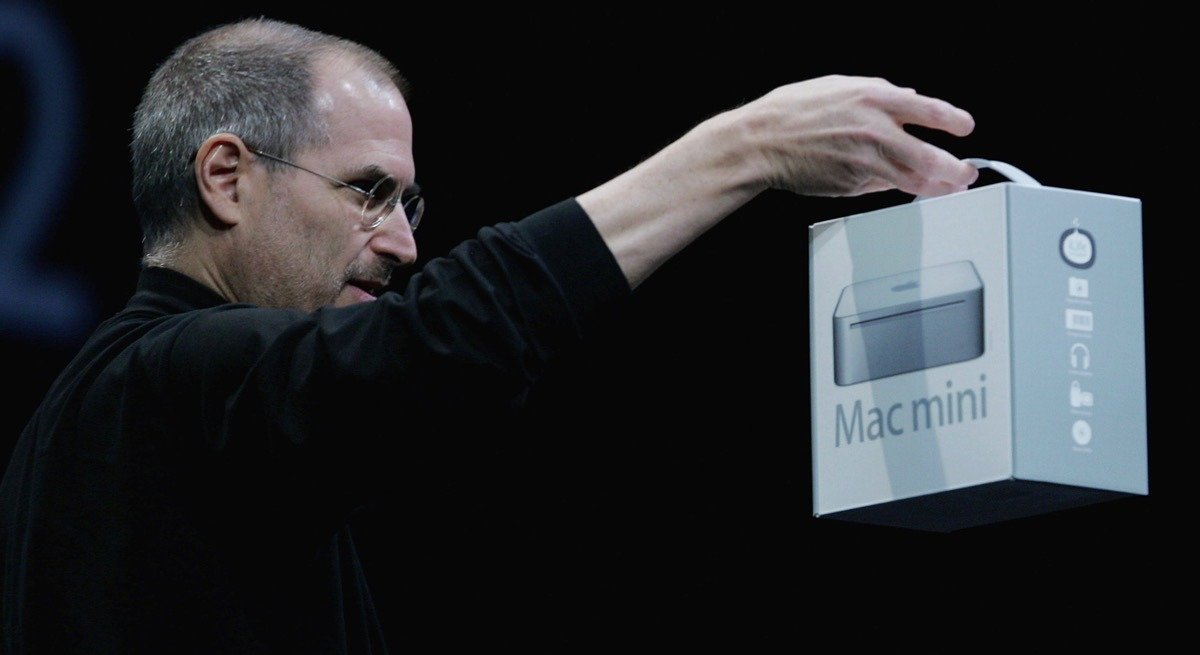
Steve Jobs with the original Mac mini box
But Jobs was right about how the Mac mini "will hook up to almost any industry standard display keyboard or mouse and it connects to almost anything on the back."
That original Mac mini offered FireWire, USB 2, DVI & VGA video out, Ethernet, and a slot-loading optical drive. The base model came with a 1.25 GHz PowerPC G4 processor, 256MB RAM, 40GB hard drive, and it cost $499.
For an extra hundred dollars, the hard drive was bumped to 80GB, and the processor came in at 1.42 GHz.
"We want to price this Mac so the people that are you know thinking of switching [from PCs] will have no more excuses," said Jobs. "People that want a second Mac in their household or a third or fourth, [it's] really going to be easy."
In today's money, that $499 from 2005 is the equivalent of about $760. Currently Apple sells the Mac mini from $699, so it's even a little cheaper now -- and gigantically more powerful.
Back in 2005, the performance it had then, the small design, and especially that price, made an impact.
How the Mac mini was received
PC Magazine (original text no longer online) gave the Mac mini four out of five stars, and said it was an "attractive entry point for the Windows-to-Mac switcher." It did note that if you had to buy a keyboard, display, and mouse, then the bargain price was no longer quite such a bargain.
However, "an additional system for a Mac-centric household," it said, "or as a cheap way for Windows-based PC users to introduce a Mac into their lives, the Mac mini succeeds, stylishly."
The New York Times said that the launch signalled Apple's "bet that most consumers now see computers as simply another appliance in the modern house."
"The new Apple strategy, which moves the company deeply into the consumer electronics market, positions the new Macintosh as an entertainment and communication device," continued the newspaper. "It also promises to intensify Apple's battle with Microsoft in the personal computer market dominated by machines using Windows software."
As ever, the New York Times asked industry experts their opinion, and one notable quote came from David Yoffie, listed as a professor at Harvard Business School.
"This is not going to return Apple to a high level of profitability," said Yoffie. "The margins on these new machines will be trivial. And I think they will add no more than one or two points of market share."
The New York Times later corrected a little omission from the original article, adding in the detail that Yoffie was also on the board at Intel.
Mac mini takes on a life of its own
A year later, at the launch of an updated Mac mini, Jobs talked briefly about how the machine had "been received really well" -- and also received really unexpectedly.
"People are doing all sorts of things with it that we never dreamed of when we introduced it," he said.
While he wasn't specific, two of the unexpected uses he was thinking of must surely have been the creation of a Mac mini server farm -- and of a Windows version.
The New York Times reported on that one. "Kevin Rose of TV's 'The Screen Savers' has figured out how to turn it into a Windows PC."
"Or should I say, how to take out all the Mac components and cram tiny PC components into their place," continued the paper. "As you'll see, the effort isn't really successful. He doesn't wind up with enough room for a CD drive, and he winds up having to saw off a chunk of the heat sink!"
"But it's a hilarious excursion for the imagination, and yet another example of how this little machine's potential is taking on a life of its own," concludes the publication.
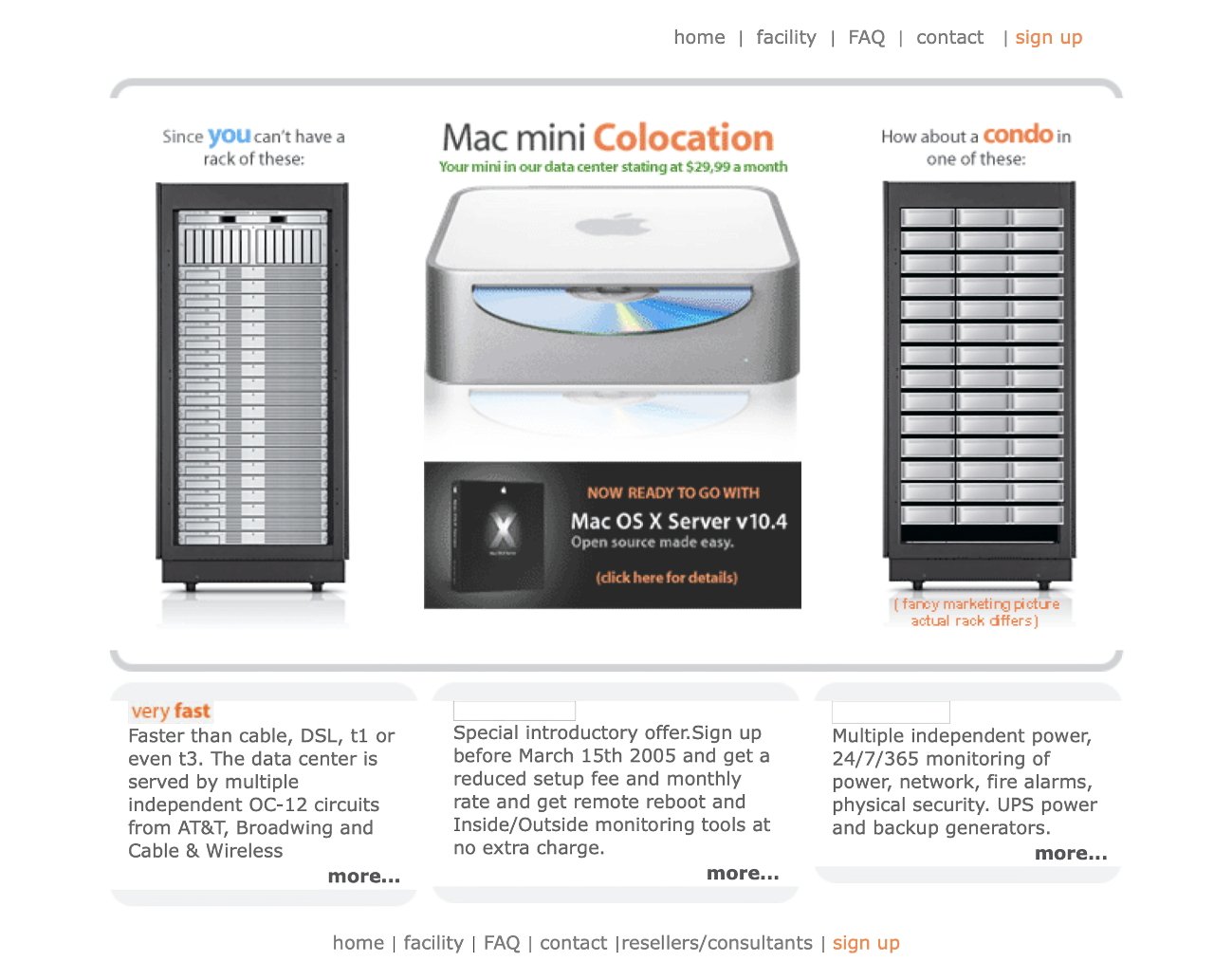
Macminicolo (now with MacStadium) offers hosting on a Mac mini farm
The server farm was just a tad more successful -- created two days after the original 2005 announcement, one such farm is still running today. Originally launched as Macminicolo, with the "colo" being short for "colocation," that firm merged with MacStadium in 2016.
First updates to the Mac mini
Presumably making Professor Yoffie happier, the 2006 main focus of the Mac mini's first revision in 2006 was to move it to Intel. One model had a single Intel Core Solo processor in, while another had an Intel Core Duo.
"And now the performance just goes into the stratosphere compared to the prior product," said Jobs, "I think we can say we've got a product that's five times faster in exactly the same form factor. So we're thrilled with this."
This first revision also upgraded to Gigabit Ethernet and two USB 2 ports. "So it's pretty great product," said Jobs.
Curiously, much of the 2006 presentation was the same as the original 2005 one, down to the same graphic representing plugging an industry-standard keyboard, display, and mouse into the device. But there was one difference.
"[You] can also hook it up to televisions," reported Jobs. "Doesn't plug into cell phones."
In fact, one now-AppleInsider staffer had done exactly that. He had hooked it up to his television with a mish-mash of DisplayPort to HDMI and a then hard-to-find HDMI audio injector.
Into the wilderness years
So that was a brand-new Mac in 2005, with a major update in 2006, which meant that things were looking great for the Mac mini. At first.
But a product can be beloved and still not sell in high numbers. See the iPhone 13 mini.
By only May 2007, there were rumors that the Mac mini was dead. "It has seen just four updates since inception," said AppleInsider at the time, "one of which was so insignificant in Apple's own eyes that the company didn't even bother to draft a press release."
"Even now, the current minis' 1.66GHz and 1.83GHz Core Duo processors are a far cry from the silicon offered in the rest of Apple's PC offerings," continued AppleInsider. "And rightfully so, as the company has seen lower margins from the units, which never gained the sales traction of its more fully equipped iMacs and MacBooks."
There was another minor spec bump a few months later in October 2007. But then by late 2008, that Mac mini server farm company, Macminicolo, felt the need to make a case that the device was still doing well.
If you include Apple's own Mac mini server, and if you counted every single tiny specification improvement, the device did get a new version most years from 2005 to 2014, but some years were more significant than others.
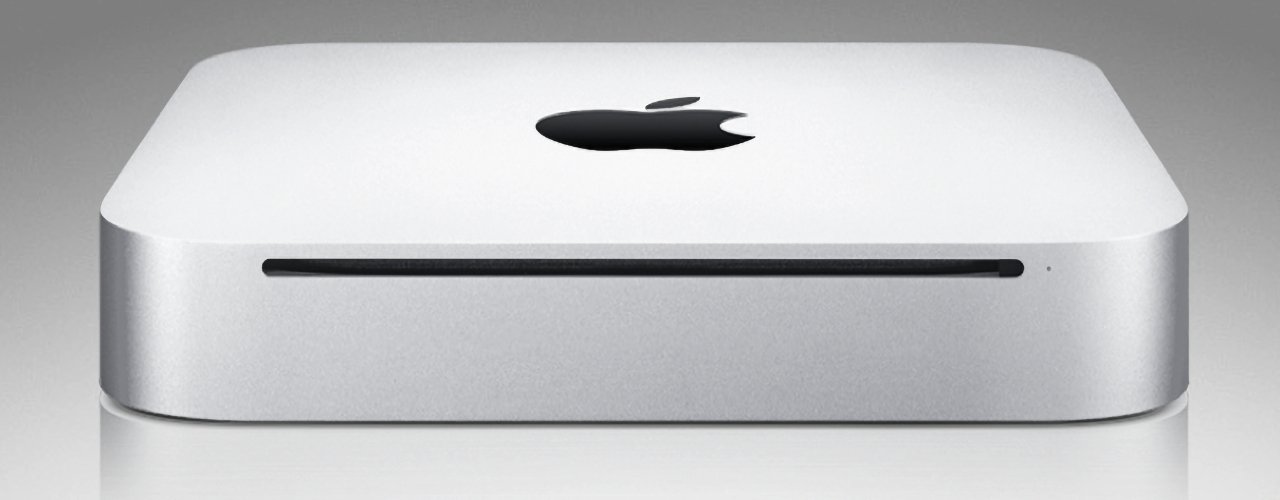
In 2010, the Mac mini got even slimmer
After the 2005 launch and the 2006 Intel refresh, the next most notable update came in 2010. The already small Mac mini became the even smaller one, with a redesign that saw the casing now made out of aluminum.
"The sleek, aluminum Mac mini packs great features, versatility and value into an elegant, amazingly compact design," said Phil Schiller at the time. "With twice the graphics performance, HDMI support and industry-leading energy efficiency, customers are going to love the new Mac mini."
That redesign made the Mac mini even smaller than it seemed, too. Every model up to then had required a separate power brick, but the 2010 one no longer did.
That tiny aluminum chassis was also what Apple calls a "unibody" one, meaning the whole case is formed out of a single piece of metal. Apart from the ports and the slot for the CD, it was whole -- and the CD drive went away shortly after.
This 2010 redesign featured a 2.4 GHz Intel Core 2 Duo processor 2GB RAM, an SD card slot, and four USB 2 ports. It cost from $699, which at the time was seen as Apple breaking away from the idea of making an affordable Mac.
Today that seems even clearer, as $699 in 2010 is approximately $950 in 2023. Or just about $200 more than the current base Mac mini.
Overall you were now paying more for the Mac mini, yet getting less. On the good side, you were getting a smaller device, but on the bad side, you were never getting inside it.
Back to basics
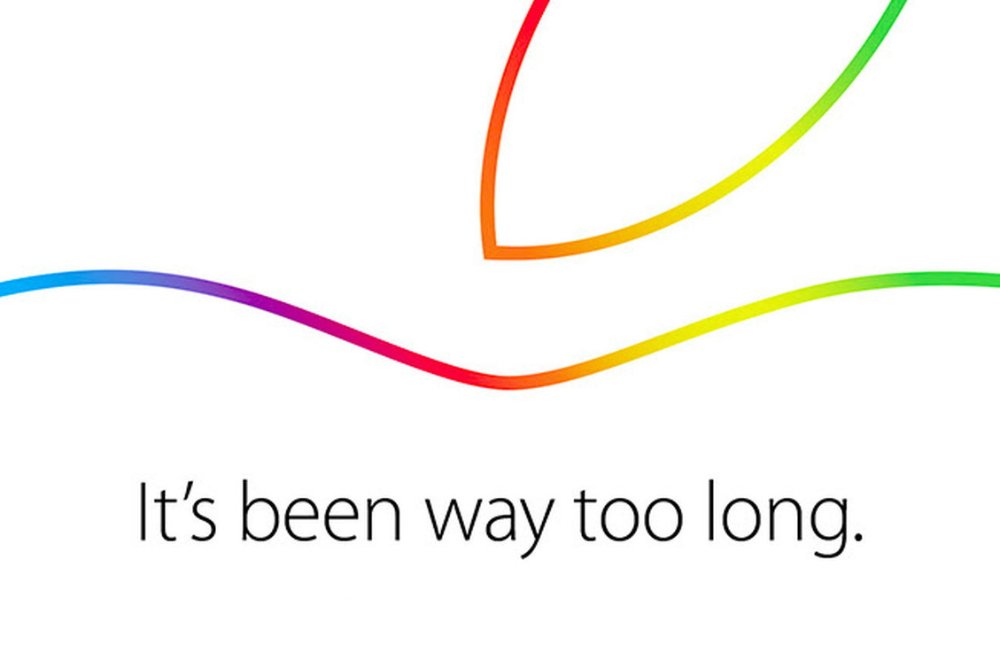
They weren't kidding.
Fast forward to 2014 -- although at the time it seemed like very slow-forward with no significant Mac mini news -- and there was a change. With an event whose invitation read "it's been way too long," Apple dropped the price back to the original $499 ($627.53 in today's money.)
But that was it.
There was nothing to see in 2015. Or 2016. Or 2017.
However, 2017 did bring the smallest glimmer of hope for Mac mini fans. Late in that year, Tim Cook replied to a user's enthusiastic email about the device.
"I'm glad you love Mac mini," wrote Cook in October 2017. "We love it too. Our customers have found so many creative and interesting uses for Mac mini."
"While it is not time to share any details," he continued, "we do plan for Mac mini to be an important part of our product line going forward."
Come on, Apple, do something
Still, by early 2018, AppleInsider was near-ready to call the Mac mini dead, though this time because it was routinely being trounced by PC rivals.
"Intel has clearly and powerfully demonstrated what can be done with the space that Apple pioneered," wrote AppleInsider. "We don't know for certain why Apple has let the mini atrophy when it didn't have to."
"It could very easily have cemented the lock it had on the segment in the early days given the scale that it operates on," it continued, "[but] almost four years since the last half-baked refresh isn't a great look."
Everything changes
The Mac mini was firmly back by the end of 2018. AppleInsider called the November 2018 refresh "Apple's mightiest mini yet."
"The new 2018 Mac mini is impressively powerful, even for the entry-level model," said the review. "It is encouraging to see Apple deliver such a well-thought-out upgrade that was desperately needed."
If only we had known what was coming. Back then, what was -- correctly -- so impressive and so welcome included how that Mac mini was based on an Intel i3 quad-core processor with a base speed of 3.6GHz, 8GB of RAM, and 128GB of PCI-E flash storage.
"[And] if you're so inclined, there are i5 and i7 versions with six cores," continued the review, "RAM options up to 64GB, and storage up to 2TB of flash storage."
The price rose again, this time to $799, but for what you got at the time, the Mac mini was a hero product again.
For about two years.
Everything really changes
By 2020, Mac mini followers were used to the peaks and toughs, and they did wonder if we were in for another long desert. But then came WWDC 2020 -- and the reveal of Apple Silicon.
The only machine Apple actually launched at that WWDC was the Developer Transition Kit -- but it was a Mac mini. The very first ARM-based Mac was a special developer version of the Mac mini.
And then one of the very first commercial releases of Apple's radically improved processors was in the November 2020 launch of the M1 Mac mini.
True, that model cut down on the number of ports we were used to with the Mac mini. This is solvable at additional expense, of course, with a Thunderbolt dock.
What is not fixable after the fact, is there is nothing else internally at all about it that can be upgraded by the user after purchase. Get what RAM and internal storage you need from the start.
"[But the] 2020 Apple Silicon M1 Mac mini is an impressively powerful machine," concluded AppleInsider. "It will only get more powerful as software is optimized for the new architecture."
More peaks and troughs
Since those first M1 Macs, we've had M2 ones as well, just not an M2 Mac mini. It's now about two years and two months since that Mac mini was launched and there's been nothing since.
There have been rumors, in fact many rumors of an ever-impending M2 refresh of the Mac mini.
But as much as that is awaited, as much as it's hoped for, no one is predicting that the Mac mini is dead anymore.
Read on AppleInsider




Comments
With those specs, I could see myself buying 4 of them.
I too will pick up an M2 Mini as soon as it goes on sale. Didn't need it when the M1 was released, but I could use it now. Waiting a few more months doesn't matter for me.
Just one example of brilliant marketing.
On the other hand, COVID+Xi = production disaster (not exactly an issue for Apple Silicon itself, just the devices they go into).
Intel and AMD appear to be plugging away while Apple stagnates, but Intel and AMD's chips go into a wide range of products, including products that are not assembled in China. Apple is heavily dependent on China, though trying to diversify.
I don't like letting Apple off the hook on this, though. It is really annoying. If mid-2024 rolls around and Apple hasn't improved the tempo of upgrading Apple Silicon, then I think it will be evidence that the benefits of moving to Apple silicon are not everything we all hoped they would be.
https://www.pcmag.com/news/former-intel-engineer-explains-why-apple-switched-to-arm
Apple also makes better margins on their own chips. There's no way they could sell a 28-core Xeon at $4k like the Studio and definitely not in that form factor.
Apple Silicon also runs near silently, all while they have best-in-class 3TFLOPs+ integrated graphics and lots of unified memory.
Intel CPU performance gains were 10x in 10 years ( https://browser.geekbench.com/mac-benchmarks ). That's about 1.25x per year. Apple jumped 2x CPU and probably 3x GPU in a single year when they switched, which gained them an instant 3 year lead.
They obviously can't keep doing 2x every year because TSMC doesn't change nodes every year so subsequent upgrades will be slower (likely 2x every 2-3 years) but they will use the best tech available.
If they hadn't switched, they'd be 3 years behind on a slower roadmap. Intel only got a jump start after Apple ditched them and AMD has to keep pace with Intel. The 3nm Apple Silicon will blow people away again but they have to wait for TSMC manufacturing.
1. Yoffie wasn't wrong. The Mac Mini never became a major seller.
2. This current Mac Mini situation is nuts. Where before you could get Core i3-i7 versions, now you can only get either an M1 Mini or one with a Core i5 that Intel discontinued in 2021 that starts at $1100.
3. The Intel vs Apple Silicon line that @Marvin is pushing is ... strange. It ignores that Intel's entire problem was being stuck on 14nm from 2015-2019 and then on 10nm from 2020-2023. Note that these problems were never due to Intel's lack of expertise, but rather horrible management decisions that was holding the engineers back. As those managers are gone, Intel will issue 7nm in 2023, 6nm and 5nm in 2024 and 3nm chips in 2025. So while comparing the 5nm M1 to 14nm 10th gen Intel chips in 2020 was "fun" and you are going to get some yucks bragging over how the 3nm M3 is going to trash Intel's 7nm 14th gen this year, watching Intel effectively close the gap in 2024 and 2025 won't be fun at all. Even if TSMC has their next process ready in 2025 (unlikely) it is only going to be a "meh" 3nm vs 2nm difference.
Let me give you an example of what I am talking about. Later this year, Intel is going to introduce the N200, which is going to replace the Core i3 line that was in the MacBook Air. It will have a 6W TDP (the M1 MacBook Air has a 10W TDP), offer a 12 hour battery life with multicore benchmarks that - based on Notebook Check and a Chromebook enthusiast site claims - will land somewhere between the Core i5 that was in the 2018 13" MacBook Pro and the Core i5 that was in the 2020 13" MacBook Pro. Best part: the N200 will be in devices that cost as little as $400. You are absolutely certain to see a Windows 11 tablet running the N200 to compete with the iPad Air before the year is out. (With ChromeOS knockoffs soon to follow.) And this is their first stab at the N200, and on a 10nm process. Imagine what the 3rd gen on a 3nm process will be like in 2025.
Also take a look at AMD. Before they stayed on the sidelines of the Apple Silicon versus Intel debate, but now they are using their 4nm chips to call Apple out.
They didn't even have to wait this long, because their 2022 Threadripper - the line that competes with the Intel Xeon W in Mac Pros - crushed the M1 Ultra. Well actually they did, because you can't put a Threadripper Pro 5995WX in something as small and power efficient as a Mac Studio. But if Apple puts the M2 Ultra in a Mac Pro then yes AMD will compare it to the 5nm Threadripper Pro 7000 that releases this year and the comparison won't be pretty. As for Intel, they will release 10nm Xeon W chips in a few weeks ... but 6nm Xeon W in 2024. So people who are trying to convince themselves that an M2 Ultra Mac Pro will be "fine" if it beats the 14nm Xeon W in the 2019 Mac Pro need to acknowledge that Xeon Ws on a die size that is 233% smaller than those in the 2019 Mac Pro are going to come out less than a year later which means before Apple is able to introduce another model.
Here is the real problem. Intel and AMD have several core sizes.
Gracemont/Athlon (smallest; for 13th gen and higher Intel is only using it as an efficiency core and AMD is only using theirs for Chromebook and kiosk devices)
Ryzen 3/Core i3 (small)
Ryzen 5/Core i5 (medium)
Ryzen 7/Core i7 (large)
Ryzen 9/Core i9 (huge)
Xeon/Xeon W/Threadripper/Epyc (massive)
This allows Intel and AMD to vary core sizes and counts on the same die sizes to hit a wide range of price, power efficiency and performance points. Meanwhile Apple only has a single performance core so they cannot do this. Instead, Apple can only bolt base CPU designs together to create Pro, Max, Ultra and Extreme chips. To get higher performance chips, Apple has to make them extremely large, the biggest in the industry by far, which makes them incredibly expensive, and in the process reduces their power per watt advantage proportionally. Another issue: right now Apple's chips only scale horizontally. AMD in 2021 introduced a chiplet concept, a 3-D design where chips scale vertically as well as horizontally. Intel is going to introduce a competing concept, tiles, with 14th gen later this year. AMD is initially only going to use it to significantly increase the L2 and L3 cache sizes (the Ryzen 7 5800X3D has 96MB L3 cache where the Ryzen 5800X has 32MB and the Intel Core i7-12700K has 25M). Intel's first focus will be turning discrete GPUs like the Arc A750M into integrated GPUs to compete with AMD's far superior integrated GPUs. So where before die shrink sizes were needed to make core sizes proportionally bigger, 3-D design will allow them to make the cores bigger still while stacking the other CPU components above them.
Now maybe Apple still has some stuff up their sleeves. But if they don't, by 2025 the whole "x86 is outdated and dying" and "Intel was only holding us back" talk that has been the rage size 2020 is going to look ridiculous. The issues that Apple is having with getting the Mac Pro out the door is just the start. And Qualcomm's buying Nuvia to make ARM PC chips to compete with the M1 is dead in the water already ... the AMD and Intel chips that are on the way will offer better performance and power per watt while costing a lot less, meaning that their only advantage will be having integrated 5G.
BUT -- those bad managers also laid off a lot of engineers, so the negative effects of those bad managers might be persistent. I don't know the inside of Intel, but I'm not nearly as willing as you are to assume that simply swapping out the CEO means that Intel will return to their process leadership on the announced schedule. Until I see shipping products with Intel's 7nm process (aka Intel 4), I will remain skeptical (and if those products ship in 2024, I'll still remain skeptical -- they should really be here now).
But even with process parity, Apple silicon beats x86 on performance/watt. Compare the M1 Ultra to the AMD 7950X and you can see that. The ARM ISA + Apple design advantages are real, above and beyond process. The flip side, though, is that Intel (more so than AMD) offers a slew of SKUs to meet almost every conceivable market niche, so they can offer more targeted products than Apple (eg, mix of big and little cores). Apple could counter that by offering more diversity themselves, but Apple only gets credit for that if they actually do it.
Another consideration is that Intel wants to be a real foundry so if Intel actually does reclaim process leadership, Apple can just pay Intel to fab their chips instead of (or in addition to) TSMC. In that scenario, I think Apple Silicon would continue to be superior to x86 for the specific markets that Apple cares about, while x86 would win in markets that Apple doesn't target.